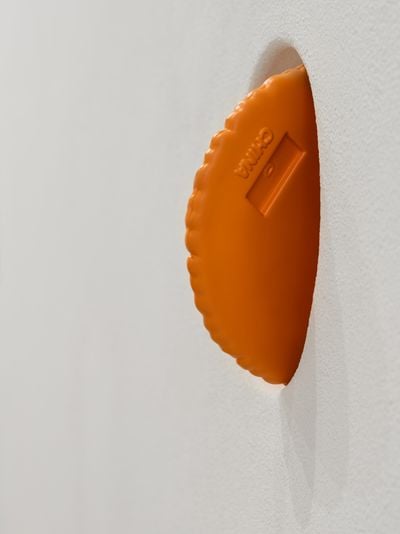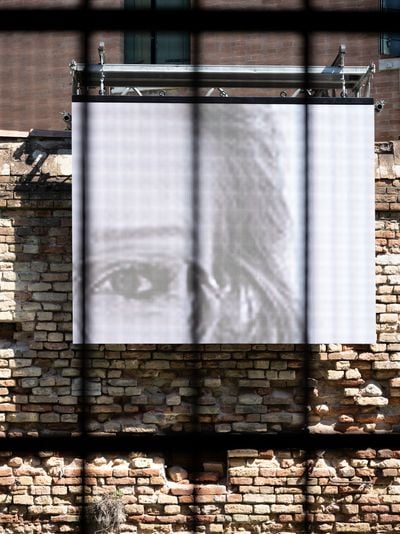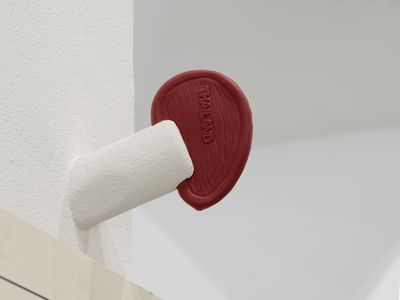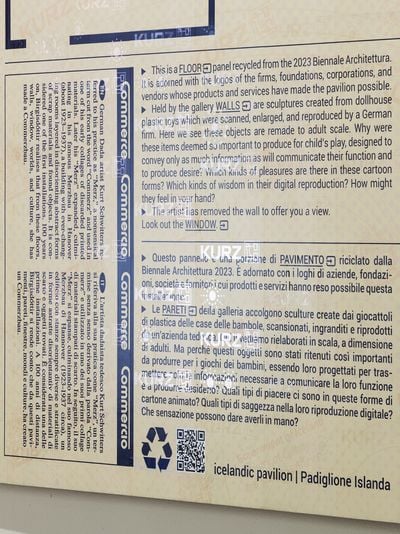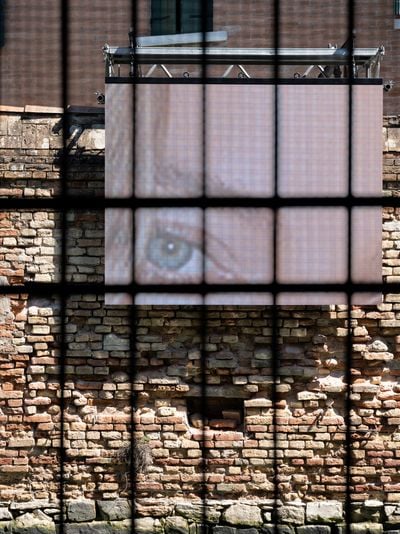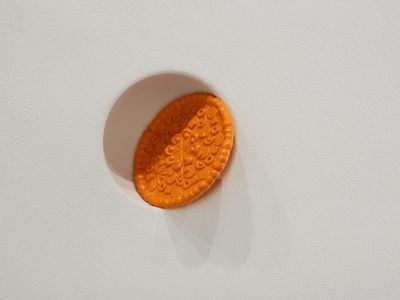
17 Apr Hildigunnur Birgisdóttir: ‘I’m a Very Material Girl’ | Conversation
Source Credit: Content and images from Ocula Magazine. Read the original article - https://ocula.com/magazine/conversations/hildigunnur-birgisdottir-venice-biennale-2024/
Hildigunnur Birgisdóttir appears on my screen in owl-eyed glasses and a tangle of copper hair. It’s 11am in Venice on 3 April, the morning after she arrived to install her exhibition for the 60th Venice Biennale, and she’s radiating at least a couple of espressos’ worth of nervous energy.
‘I had the expected shock of nothing being as it should have been, which was expected,’ she says, ‘so it’s really not that unexpected, right?’
Being shocked by the expected is an apt description of Birgisdóttir’s practice, which marvels at the improbability of ostensibly mundane materials and processes. She changes the scale or context of mass-produced items to help us see them with fresh eyes. In Venice, for instance, a plastic toy lettuce is sized up and embedded in the wall.
Hildigunnur Birgisdóttir, 6:1 (green) (2024). Polyamide plastic, paint. Exhibition view: Iceland Pavilion, 60th Venice Biennale (20 April–24 November 2024). Photo: Ugo Carmeni.
Born in 1980 in Reykjavík, where she is still based, Birgisdóttir graduated from the Iceland Academy of the Arts in 2003. She’s represented by i8 gallery and has works in the collections of the National Gallery of Iceland, the Reykjavík Art Museum, and The Living Art Museum—all of which are in the Icelandic capital.
She has performed at MoMA PS1 in New York and TBA 21 in Vienna as one of the ‘friends’ in the travelling art troupe Ragnar Kjartansson and Friends, and participated in group shows at GES-2 House of Culture in Moscow (curated by Kjartansson) and H2H in Athens, but the Venice Biennale is by far her biggest stage so far. Her exhibition for the Iceland Pavilion, That’s a Very Large Number – A Com-Merz-Bau, is curated by American Dan Byers.
Hildigunnur Birgisdóttir, Very Large Number (2024). Archival pigment print on cotton paper and sticker. Exhibition view: Iceland Pavilion, 60th Venice Biennale (20 April–24 November 2024). Photo: Ugo Carmeni.
SGA Merzbau (or Merz building) is German dadaist Kurt Schwitters‘ name for a room- or even house-sized installation made up of assemblages and collages. He purportedly took the nonsense term ‘Merz’ from the name Commerzbank, which appeared on a scrap of paper in one of his collages. But commerce is particularly important in your practice as a driver of production and a measure of value. Can you describe your Com-Merz-Bau for us?
HBThe show furthers my speculations on the situation of things as a human being in a human context on an Earth that revolves around the sun. The more I’ve breathed into being that person that wakes up every morning surprised that this has been the final conclusion of us inhabiting this Earth, I have allowed myself to be in that space in a more painterly manner, where I take these samples of what we have done and invite you to experience them, question them, and see their beauty in a way that you might never have done before.
Hildigunnur Birgisdóttir with her exhibition, That’s A Very Large Number – A Com-Merz-Bau, Iceland Pavilion, 60th Venice Biennale (20 April–24 November 2024). Photo: Ugo Carmeni.
I’ve allowed myself to use that word ‘painterly’ lately, even though I mostly use pre-made processes like factories and people that do architecture or work with theatre. I use things that are already there. Just like using found objects, I also use found techniques.
There was no pre-selection for Venice—I was just chosen—so I allowed myself to do another show. That’s nice when you’re going into this arena of the Biennale, wearing your fanciest clothes and doing your best show ever with ten exclamation marks, to take it down a notch and just do the next works that were coming to me.
Hildigunnur Birgisdóttir, Fake News [never!] (2024). Printer interface, Arduino system. Exhibition view: Iceland Pavilion, 60th Venice Biennale (20 April–24 November 2024). Photo: Ugo Carmeni.
SGYou seem a bit in disbelief about where you’ve arrived personally, just as you seem a bit in disbelief about where we’ve arrived as a species.
HBYes, for sure, and it’s been like this since I was a kid. Living on a tiny island, I got a Barbie doll for my seventh or eighth birthday, and I realised if I was getting one, how many of them must they make? All of them came in a specific package and it just blew me away. I’m a very material girl, and I was like, how can this be made from this Earth? I was infatuated with processes and how things were made and how many things were made. Then I was really concerned. How can this go on? Do we continue to make new Barbie dolls for every single girl out there? It sounds like some sort of feminist critique, but I was just infatuated with how perfect the wrapping was and dismayed that you were supposed to throw it away.
Hildigunnur Birgisdóttir, 6:1 (orange) (2024). Polyamide plastic, paint. Exhibition view: Iceland Pavilion, 60th Venice Biennale (20 April–24 November 2024). Photo: Ugo Carmeni.
SGToys are also a part of this exhibition—small plastic objects like a lettuce and a Cheeto-orange pizza—which you’ve scaled up to the size of their supermarket counterparts. What interests you about them?
HBThey are our alternative reality. It’s the reality we expose to our children for them to understand how kitchens work. I’m always interested in how we project our world, or how our cognitive minds see this ideal world that we have made. Comparing it to the actual thing is kind of hilarious.
Hildigunnur Birgisdóttir, Approx. 7% (2024). LED screen, live feed from a digital billboard in Reykjavík. Exhibition view: Iceland Pavilion, 60th Venice Biennale (20 April–24 November 2024). Photo: Ugo Carmeni.
I often use some sort of obstruction—I change the scale, I hide a part of the work, or I put it in a completely different context—so that you can actually see it. Rather than your cognitive mind going, oh, that’s a chair, I’ve hidden it where you need to travel to all the stations in your brain to meet this chair for the first time.
What I love about these plastic objects, these toys, is that they have already done this abstraction for me by being miniatures, and they’ve simplified forms to a ridiculous degree. This is on the verge of not being recognisable as a pizza, but it is still a pizza. I allow this moment where you’re like, huh, there was a human decision to make this pizza where the mushroom is in exactly the same location on every single slice. What does that say about us?
It’s amazing. I want to marvel at it, but I’m also concerned. Those feelings coexist in my body constantly.
Hildigunnur Birgisdóttir, 6:1 (burgundy) (2024). Polyamide plastic, paint. Exhibition view: Iceland Pavilion, 60th Venice Biennale (20 April–24 November 2024). Photo: Ugo Carmeni.
SGConcerned for the environment, right? And then one of the ways that you reconcile that concern and amazement, it seems to me, is to laugh.
HBTo laugh, for sure. I mean, that gets people through cancer treatments. I was a very morbid child, just to get it out of the way, and I was afraid that everyone would die around me. But then I had an epiphany lying on my back in my snow suit in the afternoon. It was dark because it’s Iceland. It was so star-bright, and I was just looking up and realising that I am nothing but a tiny speck. There’s this moment that kids have, when you get told that the sun will explode and you’re like, what?! And then everybody just goes about their day afterwards and you’re like, nothing will ever be the same!
Hildigunnur Birgisdóttir, Table and Chairs and Healthy Gums. (2024). ‘Healthy Life’ wet wipes. Exhibition view: That’s A Very Large Number – A Com-Merz-Bau, Iceland Pavilion, 60th Venice Biennale (20 April–24 November 2024). Photo: Ugo Carmeni.
That helped a lot with my anxiety, and it made me understand that everything is important and nothing is important. I am dog shit, dog shit am I. It was just like, wow, this amazing feeling of relief. That was the first stage of accepting this anxiety. I was like, yeah, people are making all these plastic objects, but we are just specks. Bacteria will survive.
But then of course, you’re a human being and you love people, and you even love people you’ve never met. I think people should have a nice life. Then anxiety hit again later in life and I was like, I still need to deal with this. It’s not enough that I am dog shit and dog shit am I. That resulted in these hyperaware sculptures that are both aware of themselves somehow in the context of art, but also in production.
Hildigunnur Birgisdóttir, Approx. 7% (2024). LED screen, live feed from a digital billboard in Reykjavík. Exhibition view: Iceland Pavilion, 60th Venice Biennale (20 April–24 November 2024). Photo: Ugo Carmeni.
Laughing about it relieves some tension, but also when a person is confronted by a plastic chair and has a moment, that is something for me. Also, realising that I am a part of the system and most of the things that I reuse in my artwork come from me being a consumer.
I bought jeans the other day that I did not need. I need to reconcile and think about that knowing I cannot have a vantage point where I’m above or subtracted from the system. That was what I was saying about allowing myself to be painterly earlier. It’s like I have understood that I am deep in the midst of consumerism and I’m reporting from the belly of the whale.
Hildigunnur Birgisdóttir, Infoxication (2024). Repurposed floor from the Argentinian Pavilion in the Architectural Biennale 2023, digital print, digital embellishment with Kurz holographic transfer. Exhibition view: Iceland Pavilion, 60th Venice Biennale (20 April–24 November 2024). Photo: Ugo Carmeni.
SGWhy does being painterly let you off the hook for buying a pair of jeans that you don’t need?
HBIt doesn’t really let me off the hook, but the painterly part is allowing myself to not have an agenda. I just want to see these things together and create beauty. I see beauty in being a human being who bought jeans that I maybe did not need.
SGIt’s so frustrating because even as good consumers, just trying to maximise our own utility, we can never optimise. We always mess up. And then to add sustainability on top of that, my god, what a miserable existence to always be optimising every dollar and every carbon mile! It’s no way to be.
HBOne of the works in your exhibition is a floor panel recycled from the 2023 Venice Architecture Biennale that is printed with the logos of all the companies you engaged in the production of the exhibition—there’s Barbie, Google, DHL, Sutton, Iceland Air, and many I didn’t recognise, such as embossing company Kurz and NovaStar, who provide LED displays. Over the logos you’ve applied this holographic film, the kind used to establish that currency or Pokémon cards are authentic. In a consumerist world, everyone’s clamouring for both attention and trust, which I guess is also a metaphor for artists competing for audiences in Venice.
Hildigunnur Birgisdóttir, Infoxication (2024) (detail). Repurposed floor from the Argentinian Pavilion in the Architectural Biennale 2023, digital print, digital embellishment with Kurz holographic transfer. Exhibition view: Iceland Pavilion, 60th Venice Biennale (20 April–24 November 2024). Photo: Ugo Carmeni.
It’s this overload of information on a piece of wood that I acquired from the Argentinian architecture pavilion and I crushed it on there with all the information you need to know about the show. I had to deal with so many companies to make one tiny exhibition in Venice. I think it’s interesting if it can be perceived as an artwork or if people will still look at it as a wall text because there’s this consensus when you walk inside the pavilion, you’re like, ah, wall text, this is not art.
The holographic film was inspired by a piece of paper that was in some sort of lighting system that I was buying for my home. It was the most decorative thing I’d ever seen in my life. It had a holo foil and information: ’20 watts’, ‘not under three years old’, ‘danger’. When you have all this information, you don’t know if it’s important that it’s called ‘alpha’ or that it’s 30 volts, which is how the world feels now.
Hildigunnur Birgisdóttir, Approx. 7% (2024). LED screen, live feed from a digital billboard in Reykjavík. Exhibition view: Iceland Pavilion, 60th Venice Biennale (20 April–24 November 2024). Photo: Ugo Carmeni.
SGHow did you come to art, and to be an artist?
HBI was a child with a very wired brain, and I didn’t really see a future. I couldn’t see an adult me functioning in the world. For me, that was like having a briefcase and going into a bank and demanding something. I couldn’t see that I would buy a house—that was ridiculous to me—so I thought I might die.I remember going to a show in Iceland and there was a work by Kristján Guðmundsson, one of the godfathers of conceptual art in Iceland. It was a book called Once around the sun (1975) and it has a dash for every second that passes during the Earth’s journey around the sun. All of a sudden I was on the ground in orbit around the sun. It’s amazing that a book can do this. I didn’t think I might become an artist, but I understood there were people in the world who thought like me.
Hildigunnur Birgisdóttir, 6:1 (orange) (2024). Polyamide plastic, paint. Exhibition view: Iceland Pavilion, 60th Venice Biennale (20 April–24 November 2024). Photo: Ugo Carmeni.
SGI love that. As a teenager I decided that unless you can communicate something in a way that hasn’t been communicated before, you can’t trust that anyone is real or anything means anything. It could all just be the same thought passing from brain to brain like a virus. I became very distrustful of anything that was unoriginal and went looking for signs of life.
HBOh my god, this is so near to me. I have always been looking at value, which ties to currency and humanity’s biggest problems and all that, but slowly my work has been morphing into consciousness, and that’s a whole new thing that I’m so excited about. I might just be doing the stuff the computer wants me to do. I’m just conscious; that’s my only virtue. —[O]
Source Credit: Content and images from Ocula Magazine. Read the original article - https://ocula.com/magazine/conversations/hildigunnur-birgisdottir-venice-biennale-2024/


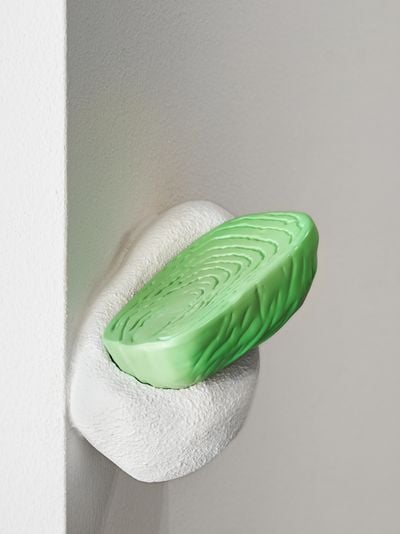

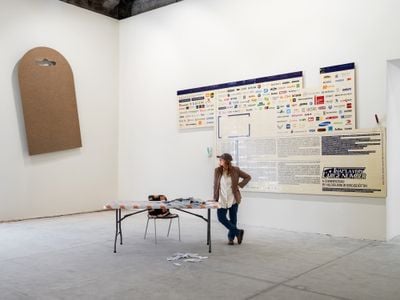
![Hildigunnur Birgisdóttir, Fake News [never!] (2024). Printer interface, Arduino system. Exhibition view: Iceland Pavilion, 60th Venice Biennale (20 April–24 November 2024). Photo: Ugo Carmeni.](https://artnewsglobal.com/wp-content/uploads/2024/04/10IcelandicPavBiennaleVenezia2024phUgoCarmeni_400_0.jpg)
